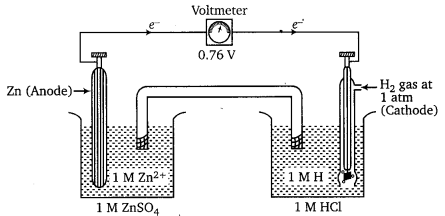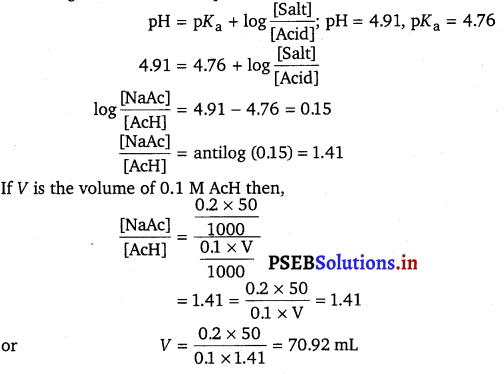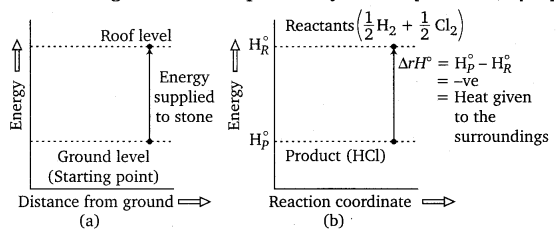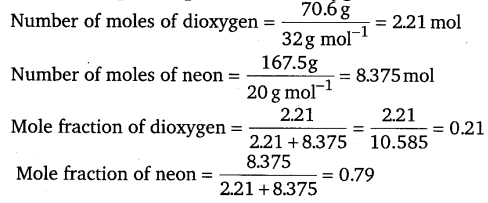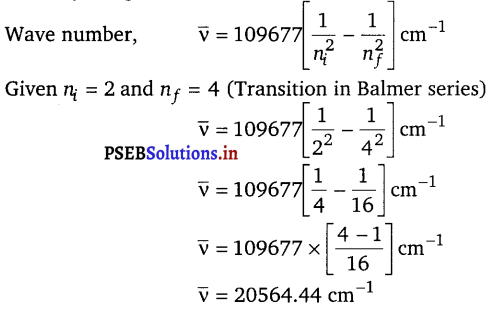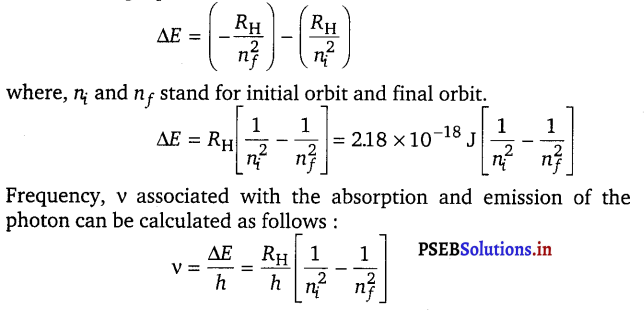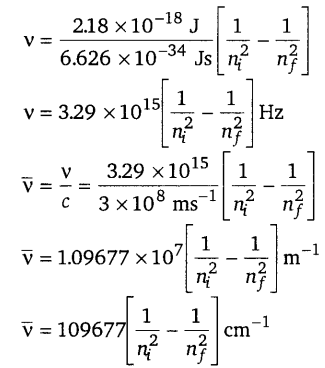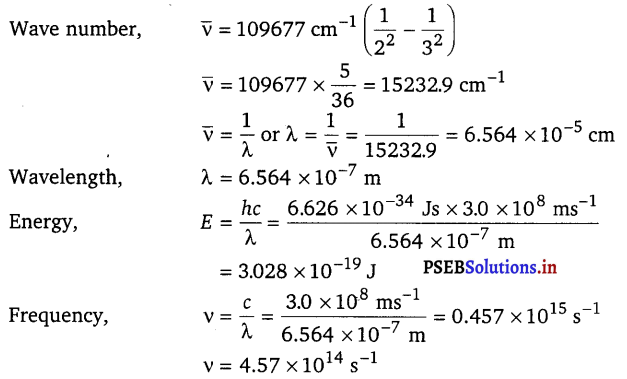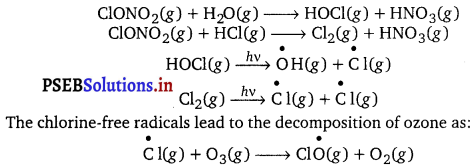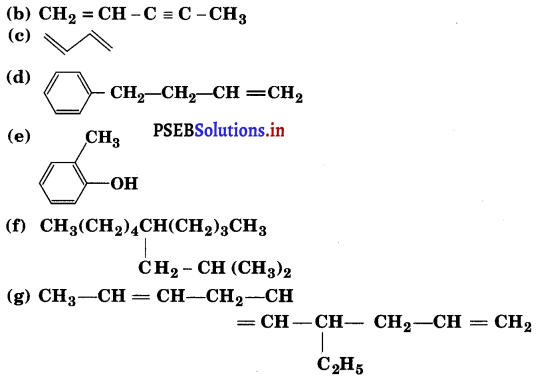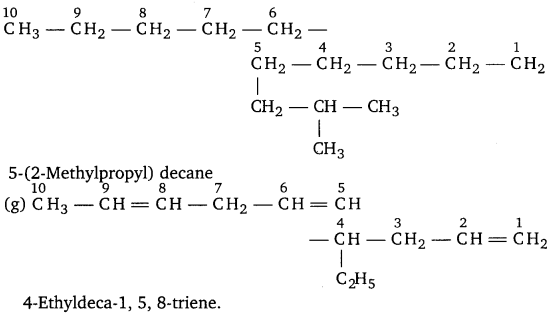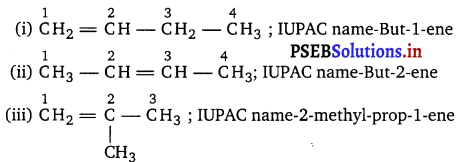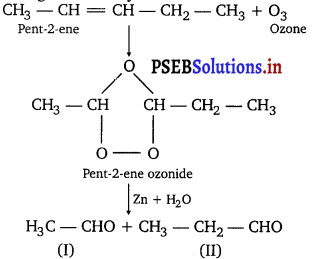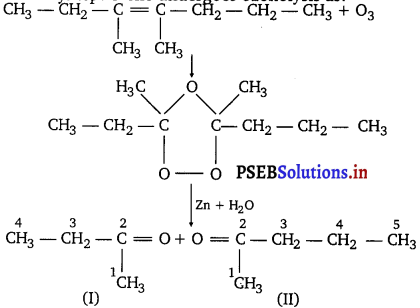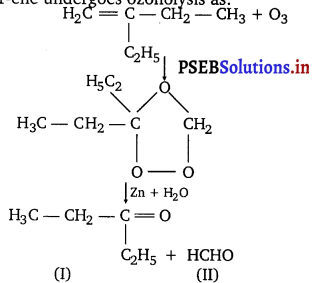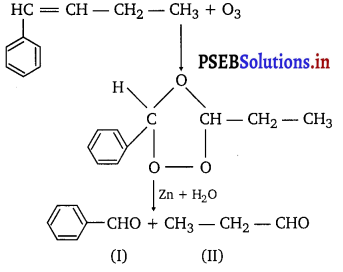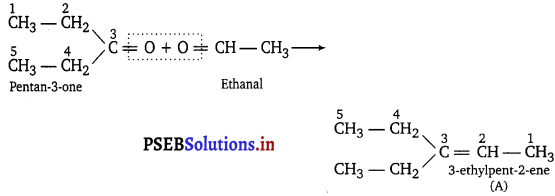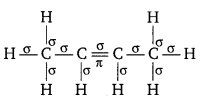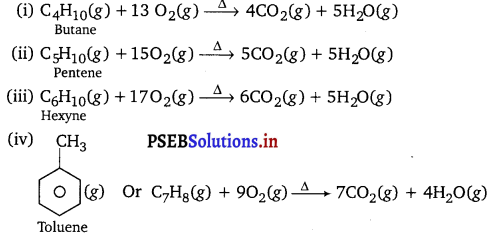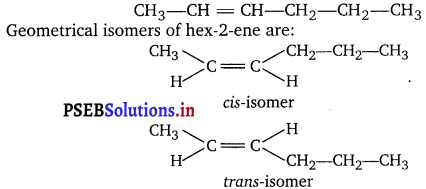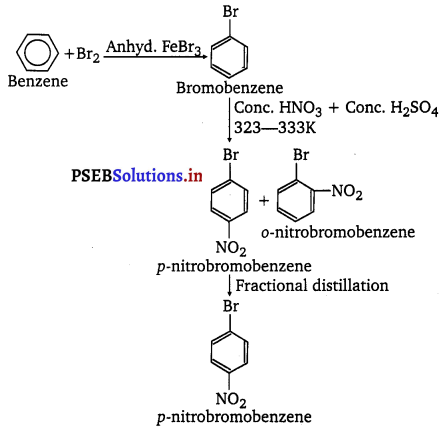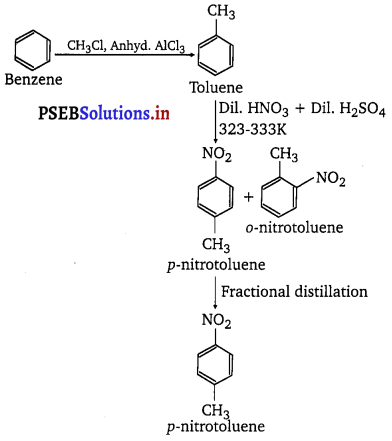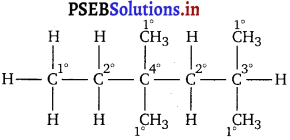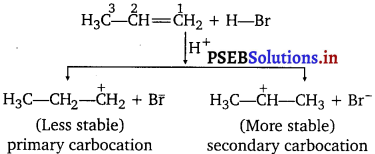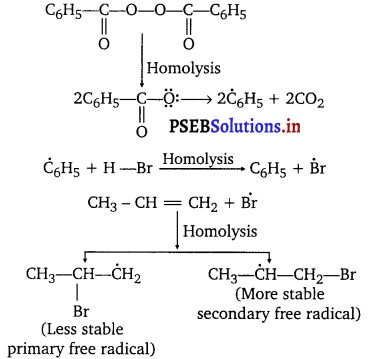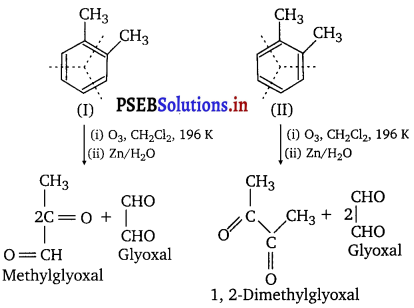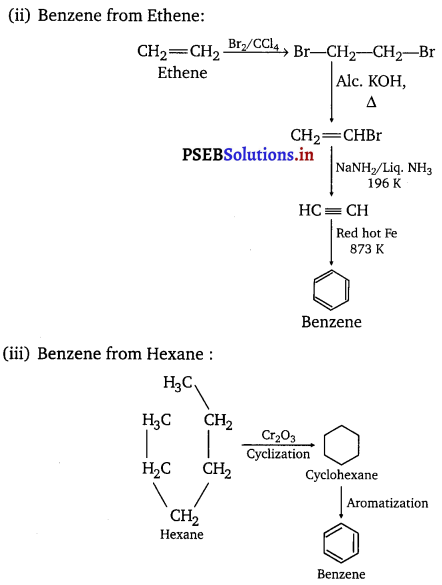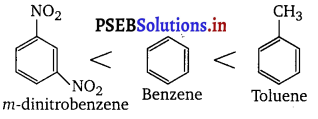Punjab State Board PSEB 11th Class Chemistry Book Solutions Chapter 12 Organic Chemistry: Some Basic Principles and Techniques Textbook Exercise Questions and Answers.
PSEB Solutions for Class 11 Chemistry Chapter 12 Organic Chemistry: Some Basic Principles and Techniques
PSEB 11th Class Chemistry Guide Organic Chemistry: Some Basic Principles and Techniques InText Questions and Answers
Question 1.
What are hybridisation states of each carbon atom in the following compounds?
CH2 = C = O, CH3CH = CH2, (CH3)2CO, CH2 = CHCN, C6H6
Answer:

C — 1 is sp2 hybridised.
C — 2 is sp hybridised.

C — 1 is sp3 hybridised
C — 2 is sp2 hybridised
C — 3 is sp2 hybridised

C — 1 and C — 3 are sp3 hybridised.
C — 2 is sp2 hybridised.

C — 1 is sp2 hybridised.
C — 2 is sp2 hybridised.
C — 3 is sp hybridised.
(v) C6H6
All the 6 carbon atoms in benzene are sp2 hybridised.

Question 2.
Indicate the o and n bonds in the following molecules:
C6H6, C6H12, CH2Cl2, CH2 = C = CH2, CH3NO2, HCONHCH3
Answer:

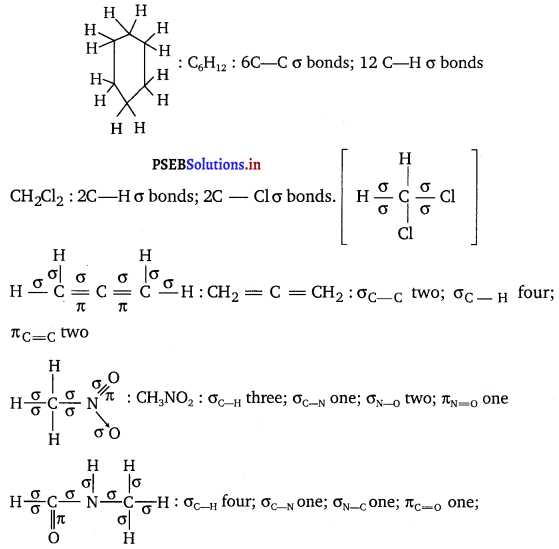
Question 3.
Write bond line formulas for : isopropyl alcohol, 2,3-Dimethyl butanal, Heptan-4-one.
Answer:
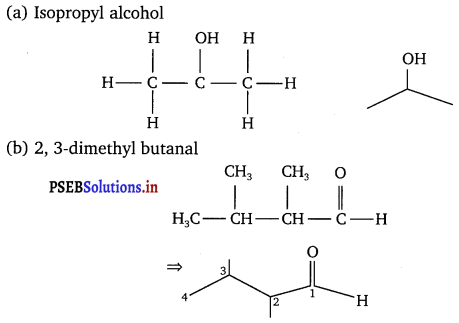

Question 4.
Give the IUPAC names of the following compounds:
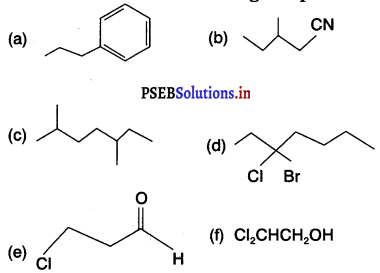
Answer:
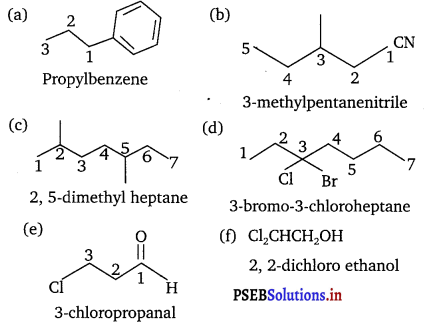
Question 5.
Which of the following represents the correct IUPAC name for the compounds concerned?
(a) 2, 2 -Dimethylpentane or
2-Dimethylpentane (b) 2,4,7-Trimethyloctane or
2,5,7-Trimethyloctane (c) 2-Chloro-4-methylpentane or
4-Chloro-2-methylpentane (d) But-3-yn-1-ol or But-4-ol-1-yne.
Answer:
(a) The prefix di in the JUPAC name indicates that two identical substituent groups are present in the parent chain. Since two methyl groups are present in the C-2 of the parent chain of the given compound, the correct IUPAC name of the given compound is 2-2-dimethylpentane.
(b) Locant number 2, 4, 7 is lower than 2, 5, 7. Hence, the IUPAC name of the given compound is 2, 4, 7-trimethyloctane.
(c) If the substituents are present in the equivalent position of the parent chain, then the lower number is given to the one that comes first in the name according to the alphabetical order. Hence, the correct IUPAC name of the given compound is 2-chloro-4-methylpentane.
(d) Two functional groups—alcoholic and alkyne—are present in the given compound. The principal functional group is the alcoholic group. Hence, the parent chain will be suffixed with ol. The alkyne group is present in the C—3 of the parent chain. Hence, the correct IUPAC name of the given compound is But – 3-yn -1 – ol.

Question 6.
Draw formulas for the first five members of each homologous series beginning with the following compounds :
(a) H—COOH
(b) CH3COCH3
(c) H—CH = CH2
Answer:
The first five members of each homologous series beginning with the given compounds are shown as follows:
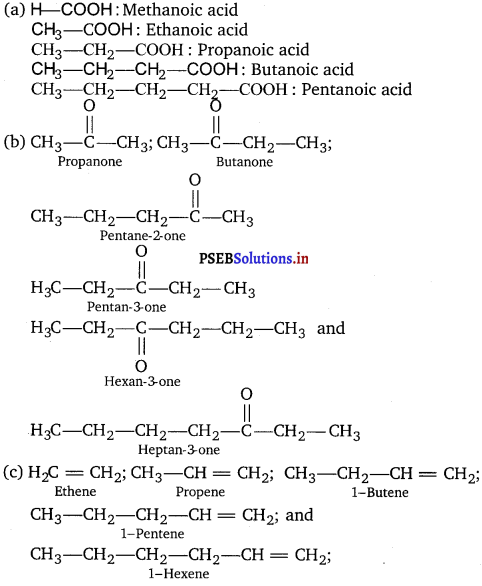
Question 7.
Give condensed and bond line structural formulas and identify the functional group (s) present, if any, for :
(a) 2,2, 4-Trimethylpentane
(b) 2-Hydroxy-1, 2, 3 -propanetricarboxylic acid
(c) Hexanedial
Answer:
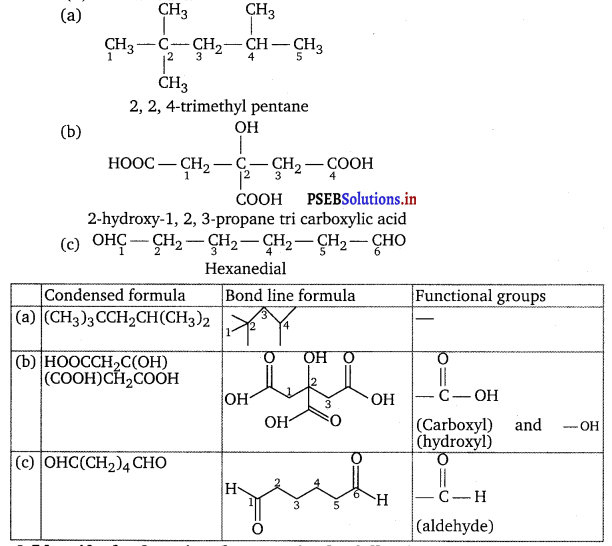
Question 8.
Identify the functional groups in the following compounds:

Answer:
The functional groups present in the given compounds are:
(a) Aldehyde (—CHO) Hydroxyl (—OH)
Methoxy (—OMe)
(b) Amino (—NH2); primary amine (1° amine).
Ester (— O—CO—)
Triethylamine [N(C2H5)2]; tertiary amine (3° amine).
(C) Nitro (—NO2)
C = C double bond (—C = C—) .
Question 9.
Which of the two: 02NCH2CH20_ or CH3CH20 is expected to be more stable and why?
Answer:
NO2 group is an electron-withdrawing group. Hence, it shows-I effect. By withdrawing the electrons toward it, the NO2 group decreases the negative charge on the compound, thereby stabilising it. On the other hand, ethyl group is an electron-releasing group. Hence, the ethyl group shows +1 effect. This increases the negative charge on the compound, thereby destabilising it. Hence, O2NCH2CH2O– is expected to be more stable than CH3CH2O–.
Question 10.
Explain why alkyl groups act as electron donors when attached to a π system,
Answer:
Due to hyperconjugation, alkyl groups act as electron donors when attached to a π-system as shown below :

Question 11.
Draw the resonance structures for the following compounds. Show the electron shift using curved-arrow notation.
(a) C6H2OH
(b) C6H5NO2
(c) CH3CH = CH CHO
(d) C6H5 -CHO

Answer:
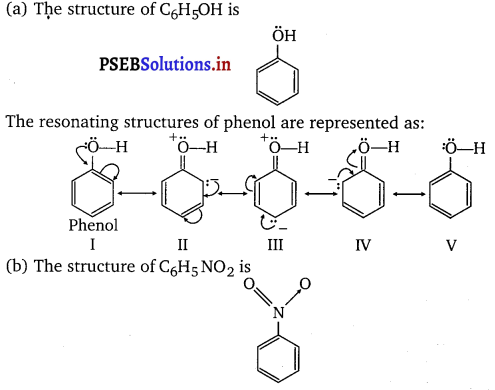
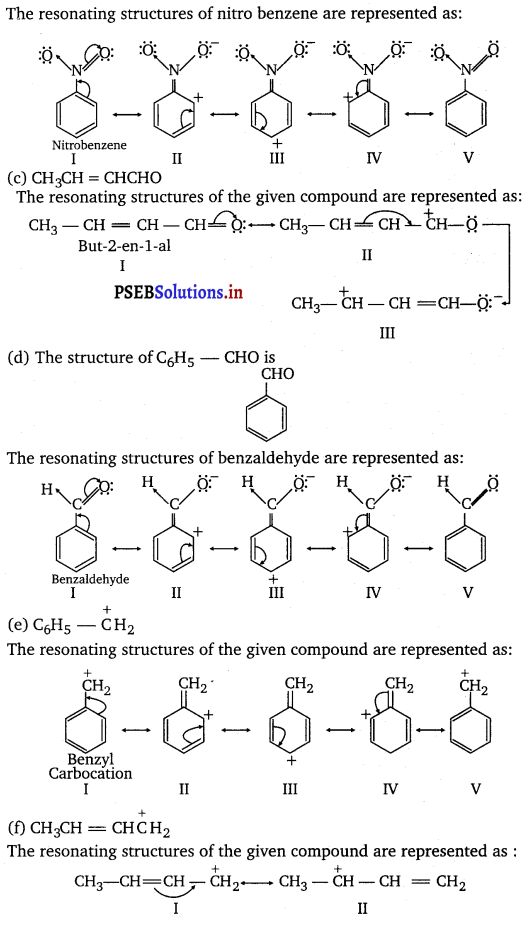
Question 12.
What are electrophiles and nucleophiles? Explain with examples?
Answer:
Electrophiles: An electrophile is a reagent that takes away an electron pair. In other words, an electron-seeking reagent is called an electrophile (E+). Electrophiles are electron-deficient and can receive an electron pair.
Neutral electrophiles :

Charged electrophiles :

Nucleophiles : A nulceophile is a reagent that brings an electron pair. In other words, a nucleus-seeking reagent is called a nucleophile.


Question 13.
Identify the reagents shown in bold italic in the following equations as nucleophiles or electrophiles:

Answer:
Electrophiles are electron-deficient species and can receive an electron pair. On the other hand, nucleophiles are electron-rich species and can donate their electrons.

Here, HO– acts as a nucleophile as it is an electron-rich species, i.e., it is a nucleus-seeking species.

Here, CN– acts as a nucleophile as it is an electron-rich species i.e., it is a nucleus-seeking species.

Here,  acts as an electrophile as it is an electron-deficient species.
acts as an electrophile as it is an electron-deficient species.
Question 14.
Classify the following reactions in one of the reaction type studied in this unit.
(a) CH3CH2Br + HS– → CH3CH2SH + Br–
(b) (CH3)2 C = CH2 +HCl → (CH3)2 ClC – CH3
(c) CH3CH2Br + HO– → CH2 = CH2 +H2O + Br–
(d) (CH3)3C— CH2OH +HBr →(CH3)2CBrCH2CH2CH3 + H2O
Ans. (a) Nucleophilic substitution reaction
(b) Electrophilic addition reaction
(c) β-elimination reaction
(d) Nucleophilic substitution reaction with rearrangement.
Question 15.
What is the relationship between the members of following pairs of structures? Are they structural or geometrical isomers or resonance contributors?
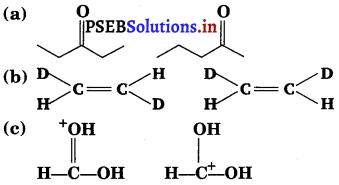
Answer:
(a) Compounds having the same molecular formula but with different structures are called structural isomers. The given compounds have the same molecular formula but they differ in the position of the functional group (ketone group.)

In structure I, ketone group is at the C—3 of the parent chain (hexane chain) and in structure II, ketone group is at the C—2 of the parent chain (hexane chain). Hence, the given pair represents structural isomers.
(b) Compounds having the same molecular formula, the same constitution, and the sequence of covalent bonds, but with different relative positions of their atoms in space are called geometrical isomers.

In structures I and II, the relative position of deuterium (D) and hydrogen (H) in space are different. Hence, the given pairs represent geometrical isomers.
(c) The given structures are canonical structures or contributing structures. They are hypothetical and individually do not represent any real molecule. Hence, the given pair represents resonance structures, called resonance isomers.

Question 16.
For the following bond cleavages, curved-arrows are used to show the electron flow and classify each as homolysis or heterolysis. Identify reactive intermediate produced as free radical, carbocation and carboanion.
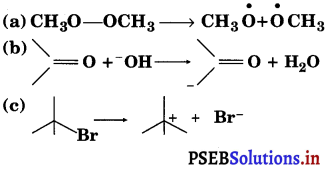

Answer:
(a) The bond cleavage using curved-arrows to show the electron flow of the given reaction can be represented as
It is an example of homolytic cleavage as one of the shared pair in a covalent bond goes with the bonded atom. The reaction intermediate formed is a free radical.

(b) The bond cleavage using curved-arrows to show the electron flow of the given reaction can be represented as

It is an example of heterolytic cleavage as the bond breaks in such a manner that the shared pair of electrons remains with the carbon of propanone. The intermediate formed is carbanion.
(c) The bond cleavage using curved-arrows to show the electron flow of the given reaction can be represented as

it is an example of heterolytic cleavage as the bond breaks in such a manner that the shared pair of electrons remains with the bromine ion. The reaction intermediate formed is a carbocation.
(d) The bond cleavage using curved-arrows to show the electron flow of the given reaction can be represented as

It is a heterolytic cleavage as the bond breaks in such a manner that the shared pair of electrons remains with one of the fragments. The intermediate formed is a carbocation.
Question 17.
Explain the terms inductive and electromeric effects. Which electron displacement effect explains the following correct orders of acidity of the carboxylic acids?
(a) Cl3CCOOH > Cl2CHCOOH > ClCH2COOH
(b) CH3CH2OOH > (CH3)2 CHCOOH > (CH3)3C. COOH
Answer:
Inductive effect : The permanent displacement of sigma electrons along a saturated chain, whenever an electron withdrawing or electron donating group is present, is called inductive effect.
Inductive effect could be +I effect or -I effect. When an atom or group attracts electrons towards itself more strongly than hydrogen, it is said to possess -I effect. For example,

When an atom or group attracts electrons towards itself less strongly than hydrogen, it is said to possess +I effect. For example,

Electromeric effect : It involves the complete transfer of the shared pair of n electrons to either of the two atoms linked by multiple bonds in the presence of an attacking agent. For example,

Electromeric effect could be + E effect or – E effect.
+E effect : When the electrons are transferred towards the attacking reagent.
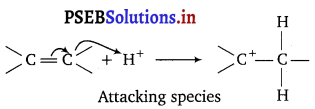
-E effect : When the electrons are transferred away from the attacking reagent.

(a) Cl3CCOOH > Cl2CHCOOH > ClCH2COOH
The order of acidity can be explained on the basis of inductive effect (-I effect). As the number of chlorine atoms increases, the -I effect increases. With the increase in -7 effect, the acid strength also increases accordingly.

(b) CH3CH2COOH > (CH3)2CHCOOH > (CH3)3C.COOH
The order of acidity can be explained on the basis of inductive effect (+I effect.) As the number of alkyl groups increases, the +I effect also increases. With the increase in +I effect, the acid strength also increases accordingly.


Question 18.
Give a brief description of the principles of the following techniques taking an example in each case.
(a) Crystallisation (b) Distillation (c) Chromatography
Answer:
(a) Crystallisation : Crystallisation is one of the most commonly used techniques for the purification of solid organic compounds. Principle : It is based on the difference in the solubilities of the compound and the impurities in a given solvent. The impure compound gets dissolved in the solvent in which it is sparingly soluble at room temperature, but appreciably soluble at higher temperature. The solution is concentrated to obtain a nearly saturated solution. On cooling the solution, the pure compound crystallises out and is removed by filtration.
For example, iodoform is crystallised with alcohol, benzoic acid mixed with naphthalene can be purified by hot water.
(b) Distillation : This method is used to separate volatile liquids from non-volatile impurities or a mixture of those liquids that have a sufficient difference in their boiling points.
Principle : It is based on the fact that liquids having different boiling points vapourise at different temperatures. The vapours are then cooled and the liquids so formed are collected separately.
For example, chloroform (b.pt. 334 K) and aniline (b.pt. 457 K) are easily separated by the distillation. On boiling the vapours of lower boiling component are formed first so it is collected first in the receiver.
(c) Chromatography : It is one of the most useful methods for the separation and purification of organic compounds.
Principle : It is based on the difference in movement of individual components of a mixture through the stationary phase under the influence of mobile phase.
For example, a mixture of red and blue ink can be separated by chromatography. A drop of the mixture is placed on the chromatogram. The component of the ink, which is less adsorbed on the chromatogram, moves with the mobile phase while the less adsorbed component remains almost stationary.
Question 19.
Describe the method, which can be used to separate two compounds with different solubilities in a solvent S.
Answer:
Fractional crystallisation is the method used for separating two compounds with different solubilities in a solvent S.
The process of fractional crystallisation is carried out in four steps.
(a) Preparation of the solution: The powdered mixture is taken in a flask and the solvent is added to it slowly and stirred simultaneously. The solvent is added till the solute is just dissolved in the solvent. This saturated solution is then heated.
(b) Filtration of the solution: The hot saturated solution is then filtered through a filter paper in a China dish.
(c) Fractional crystallisation: The solution in the China dish is now allowed to cool. The less soluble compound crystallises first while the more soluble compound remains in the solution. After separating these crystals from the mother liquor, the latter is concentrated once again. The hot solution is allowed to cool and consequently, the crystals of the more soluble compound are obtained.
(d) Isolation and drying: These crystals are separated from the mother liquor by filtration. Finally, dried the crystals.
Question 20.
What is the difference between distillation, distillation under reduced pressure and steam distillation?
Answer:
The difference among distillation, distillation under reduced pressure, and steam distillation are given in the following table :
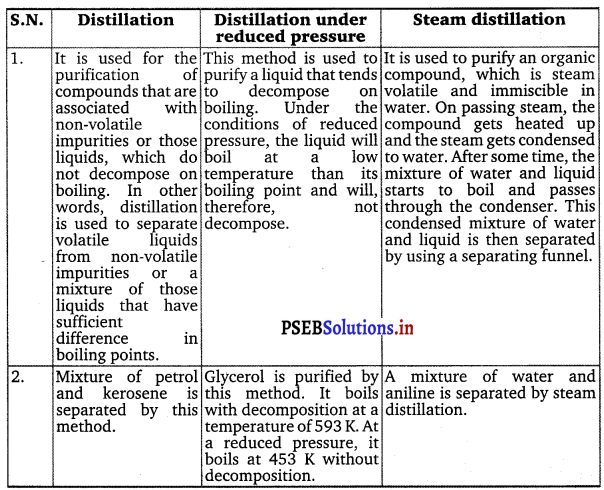
Question 21.
Discuss the chemistry of Lassaigne’s test.
Answer:
Lassaigne’s test : This test is employed to detect the presence of nitrogen, sulphur and halogens in an organic compound. These elements are present in the covalent form in an organic compound. These are converted into the ionic form by fusing the compound with sodium metal.

The cyanide, sulphide, and halide of sodium formed are extracted from the fused mass by boiling it in distilled water. The extract so obtained is called Lassaigne’s extract. This Lassaigne’s extract is then tested for the presence of nitrogen, sulphur and halogens.
(a) Test for nitrogen
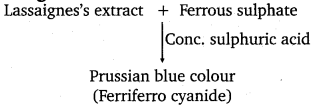
Chemistry of the test: In the Lassaignes’s test for nitrogen in an organic compound, the sodium fusion extract is boiled with iron (II) sulphate and then acidified with sulphuric acid. In the process, sodium cyanide first reacts with iron (II) sulphate and forms sodium hexacyanoferrate(II). Then, on heating with sulphuric acid, some iron (II) gets oxidised to form iron (III) hexacyanoferrate(II) which is Prussian blue in colour. The chemical equations involved in the reaction can be represented as

(b) Test for sulphur

Chemistry of the test: In the Lassaigne’s test for sulphur in an organic compound, the sodium fusion extract is acidified with acetic acid and then lead acetate is added to it. The precipitation of lead sulphide, which is black in colour, indicates the presence of sulphur in the compound.

(ii) Lassaigne’s extract + Sodium nitroprusside → Violet colour
Chemistry of the test: The sodium fusion extract is treated with sodium nitroprusside. Appearance of violet colour also indicates the presence of sulphur in the compound.

If in an organic compound, both nitrogen and sulphur are present, then instead of NaCN, formation of NaSCN takes place.

This NaSCN (sodium thiocyanate) gives a blood red colour. Prussian colour is not formed due to the absence of free cyanide ions.

(c) Test for halogens
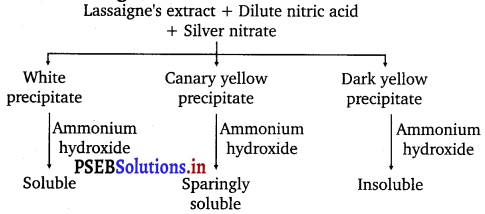
Chemistry of the test: In the Lassaigne’s test for halogens in an organic compound, the sodium fusion extract is acidified with nitric acid and then treated with silver nitrate.
x– + Ag+ → AgX (X = Cl, Br, I)
If nitrogen and sulphur both are present in the organic compound, then the Lassaigne’s extract is boiled to expel nitrogen and sulphur, which would otherwise interfere in the test for halogens.

Question 22.
Differentiate between the principle of estimation of nitrogen in an organic compound by (i) Dumas method and (ii) Kjeldahl’s method.
Answer:
(i) In Dumas method, when a known mass of the nitrogen containing organic compound is heated with excess of CuO in an atmosphere of CO2, nitrogen of the organic compound is converted into N2 gas. The volume of N2 thus obtained is converted into STP and the percentage of nitrogen is determined.
%N = \(\frac{28}{22400} \times \frac{\text { Vol. of } \mathrm{N}_{2} \text { at STP }}{\text { Mass of the substance taken }}\) x 100
(ii) In Kjeldahl’s method, a known mass of the nitrogen containing
organic substance is digested (heated) with conc. H2SO4 and CuSO4 (in little amount) in Kjeldahl’s flask. Nitrogen present in the organic compound is quantitatively converted into (NH4 )2SO4. (NH4 )2SO4 thus obtained is boiled with excess of NaOH solution to liberate NH3 gas which is absorbed in a known excess of a standard solution of H2SO4 or HCl.
The volume of acid left after absorption of NH3 is estimated by titration against a standard alkali solution. From the volume of the acid used, the percentage of nitrogen is determined by applying the equation,

Question 23.
Discuss the principle of estimation of halogens, sulphur and phosphorus present in an organic compound.
Answer:
Estimation of halogens : Halogens are estimated by the Carius method. In this method, a known quantity of organic compound is heated with fuming nitric acid in the presence of silver nitrate, contained in a hard glass tube called the Carius tube, taken in a furnace. Carbon and hydrogen that are present in the compound are oxidized to form CO2 and H2O respectively and the halogen present in the compound is converted into AgX. This AgX is then filtered, washed, dried, and weighed.
Let the mass of organic compound taken = m g

Estimation of sulphur : In this method, a known quantity of organic compound is heated with either fuming nitric acid or sodium peroxide in a hard glass tube called the Carius tube. Sulphur present in the compound, is oxidized to form sulphuric acid. On addition of excess of barium chloride to it, the precipitation of barium sulphate takes place. This precipitate is then filtered, washed, dried, and weighed.
Let the mass of organic compound taken -mg
Mass of BaSO4 formed = m1 g
% of sulphur = \(\frac{32 \times m_{1} \times 100}{233 \times m}\)
Estimation of phosphorus : In this method, a known quantity of organic compound is heated with fuming nitric acid. Phosphorus, present in the compound, is oxidized to form phosphoric acid. By adding ammonia and ammonium molybdate to the solution, phosphorus can be precipitated as ammonium phosphomolybdate.
Phosphorus can also be estimated by precipitated it as MgNH4P04 by adding magnesia mixture, which on ignition yields Mg2P207.
Let the mass of organic compound = m g
Mass of ammonium phosphomolybdate = m1 g
Molar mass of ammonium phosphomolybdate = 1877 g

Question 24.
Explain the principle of paper chromatography.
Answer:
In paper chromatography, chromatography paper is used. This paper contains water trapped in it, which acts as the stationary phase. On the base of this chromatography paper, the solution of the mixture is spotted. The paper strip is then suspended in a suitable solvent, which acts the mobile phase. This solvent rises up the chromatography paper by capillary action and in this procedure it flows over the spot. The components are selectively retained on the paper (according to their differing partition in these two phases). The spots of different components travel with the mobile phase to different heights. The paper so obtained (shown in the given figure) is known as a chromatogram.
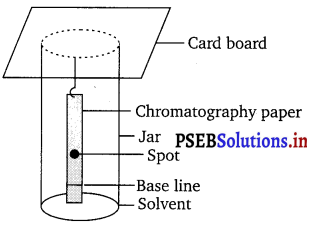
Question 25.
Why is nitric acid added to sodium extract before adding silver nitrate for testing halogens?
Answer:
While testing the Lassaigne’s extract for the presence of halogens, it is first boiled with dilute nitric acid. This is done to decompose NaCN to HCN and NA2S to H2S and to expel these gases. That is, if any nitrogen and sulphur are present in the form of NaCN and Na2S they are removed. The chemical equations involved in the reaction are represented as
NaCN + HNO3 > NaNO3 + HCN
Na2S + 2HNO3 > 2NaNO3 + H2S

Question 26.
Explain the reason for the fusion of an organic compound with metallic sodium for testing nitrogen, sulphur and halogens.
Answer:
Nitrogen, sulphur, and halogens are covalently bonded in organic compounds. For their detection, they have to be first converted to ionic form. This is done by fusing the organic compound with sodium metal. This is called Lassaigne’s test. The chemical equations involved in the test are
Na + C + N → NaCN
Na + S + C + N → NaSCN
2Na + S → Na2S
Na + X → NaX (X = Cl, Br, I)
Carbon, nitrogen, sulphur, and halogen come from organic compounds.
Question 27.
Name a suitable technique of separation of the components from a mixture of calcium sulphate and camphor.
Answer:
Calcium sulphate (CaSO4) which is an inorganic compound and does not sublime can be separated from camphor which is an organic compound and sublimes by the simple technique of sublimation. This technique involves the direct conversion of a solid into the gaseous state on heating without passing through the intervening liquid state and vice-versa on cooling. Camphor sublimes and gets-deposited on the walls of the cooler portion of the funnel and CaSO4 remains as such. The two components can thus be separated.
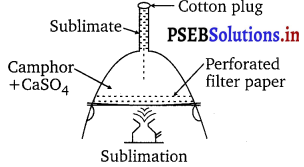
Question 28.
Explain, why an organic liquid vaporises at a temperature below its boiling point in its steam distillation?
Answer:
In steam distillation, the organic liquid starts to boil when the sum of vapour pressure due to the organic liquid (p1) and the vapour pressure due to water (p2) becomes equal to atmospheric pressure (p), that is P = P1 + P2– Since P1 < p2, organic liquid will vapourise at a lower temperature than its boiling point.
Question 29.
Will CCl4 give white precipitate of AgCl on heating it with silver nitrate? Give reason for your answer.
Answer:
CCl4 will not give the white precipitate of AgCl on heating it with silver nitrate. This is because the chlorine atoms are covalently bonded to carbon in CCl4. To obtain the precipitate, it should be present in ionic form and for this, it is necessary to prepare the Lassaigne’s extract of CCl4.
Question 30.
Why does solution of potassium hydroxide is used to absorb carbon dioxide evolved during the estimation of carbon present in an organic compound?
Answer:
Carbon dioxide is acidic in nature and potassium hydroxide is a strong base. Hence, carbon dioxide reacts with potassium hydroxide to form potassium carbonate and water as
2KOH + CO2 → K2CO3 + H2O
Thus, the mass of the U-tube containing KOH increases. This increase in the mass of U-tube gives the mass of CO2 produced. From its mass, the percentage of carbon in the organic compound is calculated as
%C = \(\frac{12}{44} \times \frac{\text { Weight of } \mathrm{CO}_{2} \text { formed }}{\text { Weight of substance taken }}\) x 100
Question 31.
Why is it necessary to use acetic acid and not sulphuric acid for acidification of sodium extract for testing sulphur by lead acetate test?
Answer:
For testing of sulphur present in the organic compound the Lassaigne’s extract is acidified with acetic acid (CH3COOH) and not sulphuric acid because lead acetate is soluble and does not interfere with the test. If sulphuric acid (H2SO4) is used, lead acetate will react with H2SO4 itself to form white ppt. of PbSO4 as follows :

White ppt. of PbSO4 so formed will interfere with this test of sulphur.

Question 32.
An organic compound contains 69% carbon and 48% hydrogen, the remainder being oxygen. Calculate the masses of carbon dioxide and water produced when 0.20 g of this substance is subjected to complete combustion.
Answer:
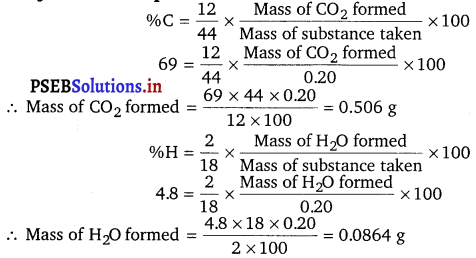
Question 33.
A sample of 0.50 g of an organic compound was treated according to Kjeldahl’s method. The ammonia evolved was absorbed in 50 ml of 0.5 M H2SO4. The residual acid required 60 mL of 0.5 M solution of NaOH for neutralisation. Find the percentage composition of nitrogen in the compound.
Ans. Volume of the acid taken = 50 mL of 0.5 M H2SO4
= 25 mL of 1.0 M H2SO4
Volume of alkali used for neutralization of excess acid = 60 mL of 0.5 M NaOH = 30 mL of 1.0 M NaOH
H2SO4 + 2NaOH → Na2SO4 + 2H2O
1 mole of H2SO4 = 2 moles of NaOH
Hence, 30 mL of 1.0 M NaOH = 15 mL of 1.0 M H2SO4
∴ Volume of acid used by ammonia = 25 – 15 = 10 mL
%of nitrogen = \(\frac{1.4 \times \mathrm{N}_{1} \times \text { Volume of acid used }}{\mathrm{W}}\)
= \(\frac{1.4 \times 2 \times 10}{0.5}\) (N1 = normality of acid and W = mass of organic compound)
= 56

Question 34.
0.3780 g of an organic chloro compound gave 0.5740 g of silver chloride in Carius estimation. Calculate the percentage of chlorine present in the compound.
Answer:
Given that,
Mass of organic compound = 0.3780 g
Mass of AgCl formed = 0.5740 g
1 mol of AgCl contains 1 mol of Cl
Thus, mass of chlorine in 0.5740 g of AgCl = \(\frac{35.5 \times 0.5740}{143.5}\) = 0.142g
∴ Percentage of chlorine = \(\frac{0.142}{0.3780}\) x 100 = 37.57%
Hence, the percentage of chlorine present in the given organic chloro compound is 37.57%.
Question 35.
In the estimation of sulphur by Carius method, 0.468 g of an organic sulphur compound afforded 0.668 g of barium sulphate. Find out the percentage of sulphur in the given compound.
Answer:
The mass of organic compound = 0.468 g
Mass of barium sulphate formed = 0.668 g
Percentage of sulphur = \(\frac{32}{233} \times \frac{\text { Mass of } \mathrm{BaSO}_{4} \text { formed }}{\text { Mass of substance taken }}\) x 100
= \(\frac{32}{233} \times \frac{0.668}{0.468}\) x 100 = 19.59%
Hence, the percentage of sulphur in the given compound is 19.59%.
Question 36.
In the organic compound,
CH2 = CH – CH2 – CH2 – C = CH, the pair of hybridised orbitals involved in the formation of C2 – C3 bond is (a) sp – sp2 (b) sp – sp3 (c) sp2 – sp3 (d) sp3 – sp3
Answer:

In the given organic compound, the carbon atoms numbered as 1, 2, 3, 4, 5, and 6 are sp2, sp2, sp3, sp3, sp, and sp hybridised respectively. Thus, the pair of hybridised orbitals involved in the formation of C2 – C3 bond is sp2 – sp2.
Question 37.
In the Lassaigne’s test for nitrogen in an organic compound, the Prussian blue colour is obtained due to the formation of:
(a) Na4[Fe(CN)6]
(b)Fe4[Fe(CN)6]3
(c) Fe2[FeCN6]
(d) Fe3[Fe(CN)6]4
Answer:
(b) The Prussian blue colour is due to the formation of ferric ferro cyanide, Fe4[Fe(CN)6]3.
Question 38.
Which of the following carbocations is most stable?

Answer:
(b) The order of stability of carbocation is 3° > 2° > 1°. 3° carbocation,

Question 39.
The best and latest technique for isolation, purification and separation of organic compounds is:
(a) Crystallisation
(b) Distillation
(c) Sublimation
(d) Chromatography
Answer:
(d) Chromatography is the best and latest technique for isolation, purification and separation of organic compounds.

Question 40.
The reaction:
CH3CH2I+KOH(aq) > CH3CH2OH +KI is classified as :
(a) electrophilic substitution
(b) nucleophilic substitution
(c) elimination
(d) addition
Answer:
(b) This is an example of nucleophilic substitution reaction. The hydroxyl group of KOH (OH–) with a lone pair of itself acts as a nucleophile and substitutes iodide ion in CH3CH2I to form ethanol.
![]()

![]()
![]()
![]()
